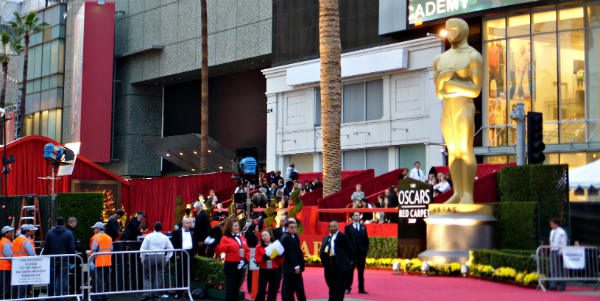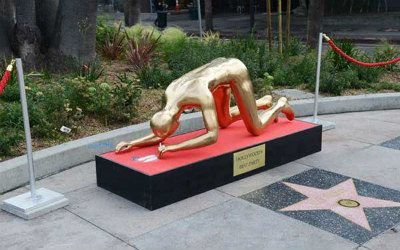There’s what Hollywood (and New York) likes at the movies, and then there’s what America likes. Every now and then those intersect at the Academy Awards, but often, they don’t.
The temptation is to say, “Well, of course! Hollywood’s all a bunch of crazy, coked-up, atheist, liberal libertines!”
That’s not entirely true, or it’s true to varying degrees (depending whom you’re talking about), but it’s also not entirely untrue.
Shining a light on Oscar’s dark side, on Thursday, Feb. 19, three days before the Sunday, Feb. 22, Academy Awards ceremony, an artist called Plastic Jesus — a former London photojournalist who moved to Los Angeles and addresses social issues with installation art — placed a life-size version of an Oscar statuette in the middle of Hollywood Boulevard, not far from the Dolby Theater, the site of the honors.
Although the piece was conceived five months ago, it hit the street the same day as 30-year-old “Parks and Recreation” executive producer Harris Wittels was found dead in his Los Angeles home from a suspected drug overdose:
Speaking to The Daily Beast, Plastic Jesus said:
“Everybody knows about cocaine, and everybody knows somebody who does cocaine on a regular basis, but it’s just not discussed Somebody out there is doing a sh*tload of cocaine and (the War on Drugs) is costing $40 billion a year. It’s just swept under the carpet.”
To Marketwatch, Plastic Jesus said via email:
“We only hear about drug addiction when a high-profile Hollywood celeb has a meltdown and goes in to rehab or dies. However there is a huge problem in Hollywood with drug use not just from the A listers but also others in the entertainment industry, producers, directors, make up artists, props guys, lighting guys and electricians. Sadly many of these people’s habits cause a negative influence and they are tossed aside when they can’t get the help they need.”
As related by The Hollywood Reporter, in 2014, Plastic Jesus did an sculpture of an Oscar with a needle in its arm, inspired by the heroin-related death of actor Philip Seymour Hoffman; and in 2013, he did a graffiti work depicting Lance Armstrong cycling while attached to an IV bag (referencing his use of performance-enhancing drugs).
While drugs are far from just a Hollywood thing, most industries don’t have internationally televised events where the participants stand up and congratulate themselves and each other on their (ahem) moral fiber and courage and then head off to parties to do, well, God knows what.
But setting all the personal and cultural stuff aside, when it comes to which movies win, it’s useful to remember that the perspective of people in the industry, regardless of their personal beliefs and proclivities, is inherently different from that of the general population.
As a journalist covering TV for more than two decades, I’ve seen a ridiculous amount of it, including shows I wouldn’t normally choose to watch. I’ve also been on more TV sets than I can count, so I’ve seen the actual production process for of a lot of these shows (it’s always amusing to see a scene and realize I was there that day, tucked off in an unseen corner).
So, my view of TV isn’t going to be the same as that of someone who just watches TV for entertainment and has never seen a show being made.
Layer on top of that the desire by Hollywood people to honor those they know, those they admire, those they’d like to work for, projects they wish they’d been in or made, and projects like the ones they want to do (the vote then being considered encouragement for more of the same).
Far down on the list is honoring movies just because the general public loved them and went to see them (the moviemakers already have their reward for those, called “box office receipts”).
Hollywood cares desperately what people want to see, because that’s how all those bills get paid, from diapers to groceries to illicit drugs, but the critical view from Hollywood Boulevard and the view from Main Street will always diverge (and not just because Main Street has fewer costumed characters, panhandlers and hookers of uncertain gender … but I digress).
Tonight at 7 p.m. Eastern (4 p.m. Pacific) on ABC (red-carpet coverage starts at 5 p.m. Eastern), we’ll find out what Oscar voters think is worthy of notice, but courtesy of the good folks at high-tech mapping company Esri, here’s an interactive map showing what American moviegoers like and how they like it.
Images: courtesy Plastic Jesus, Wikimedia Commons, Esri



















